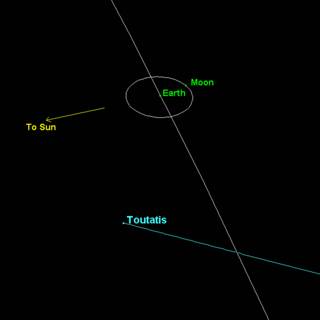At 13:35 GMT on that date, we had a brush with fate. You didn't feel it, did you? Don't worry, not many people did, and it's below most of our personal "worry radars" these days (since there seems to be so much clutter on our screens lately).
A 4.6 by 2.4 km hunk of rock called 4179 Toutatis whizzed by within 1.55 million kilometers of us. Here's a schematic:

Diagram by Paul Chodas (JPL/Caltech)

Now before you run outside, Chicken Little, this was Toutatis' closest approach since the 1300's, and no collision is likely for orbital projections over the next 500 years. Great, huh? "Errr.... you mean it's been this close before? ...and will be again?"
Why, yes, Chick Li, Toutatis is one of several hundred Earth Crossing Asteroids that, umm, ....well, are occasionally in the way as Earth trundles along around the Sun. Toutatis happens to be a particularly friendly fellow (in a gallic sort of way) because his orbit is almost coplanar with ours - that is good news and bad news. The good news: we get to have a good look at him every so often, and learn lots about asteroids. The bad news: one day he will be too close, and we will crush him. "We" being the Earth. If you are a mere human, well, then it might be you that is crushed. Or burned. Or drowned. Or starved.
...Chicken Little? Where are you? ...ah, there you are. That desk isn't going to give you much shelter against several hundred thousand tons of rock traveling at Mach 25, you know. There, there. Let's talk about risk. First of all, what does the picture above really mean? How far away was this bloodthirsty Toutatis thing, really?
Well, the picture shows that Toutatis' closest approach was about 4 times the Earth-Moon distance. The distance between them is about 384,000 km. Now - we can clearly see something that big. But how big are the Moon and Earth in this picture? The Earth is about 12,740 km across, while the Moon is about 3,476 km across. So the Earth would be about one thirtieth of the size of the orbit, and the Moon would be less than one-hundredth of the orbit. It's very likely that on your monitor, Chicken Little, the Moon is smaller than a single pixel. Now imagine how incredibly tiny Toutatis is - one-hundred thousandth of that orbit. About 0.1 micrometers on your screen. About the size of that bacteria's nucleus. No, the other one.
Now that you are pointing to the screen with your scraggly little toenails, Chicken Little, imagine how big your toenails are in that universe! As my mapping professors Clarence Allen and Leon Silver used to remind me mercilessly: "Always know how big your pencil is! How wide is your pencil mark in the real world?" So - your toenails are larger than Jupiter. (Here's a set of scissors, and don't leave the clippings on the rug.)
The point is that the real things we are referring to in that picture are actually very very very small compared to the distances between them. The distances between them are so large that we can't even use everyday objects to point them out properly - things like fingers, chicken toenails, and yes, even pixels, are just too huge. That means that what astronomers call a "near miss" is actually very far from being a "hit." Very far.
Let's look at some other near misses, past and future.
On March 31, 2004 FU162 missed us by between 4,000 and 11,000 km. Yikes! That's a lot closer than 1.55 million kilometers. But then FU162 is very small, only 5 to 10 meters across - small enough not to make it to the surface, but it would have been LOUD. We actually had a closer encounter than that - on August 10, 1972, something about that size or bigger missed us by only 53 km. more
In the "big hitter" category we have 2004 VW14, which on December 24, 2004 will pass within 1.8 million km (about 5 orbit radii away). Current interest centers around 1997 XR2 (0.23 km diam) and its approach on June 1, 2101 about a 1 in 10,000 chance of collision, or about 99.9903% likelihood of a miss. A little further on, on August 24, 2130, body 2004 QA22 will pass by between zero and 653,000 km away. Zero, of course, is a collision. This by no means should be entered in your calendar as the apocalypse - the orbital parameters for these bodies are updated frequently, changing these estimates by large amounts.
The only body for which a good degree of confidence exists for collision is 1950 DA, with a date of March 16, 2880. However the collision probablility is still only between 0 and 0.33%. (a 99.68% chance it will miss) more
Here is a decent animation of how we reduce uncertainties for asteroid postions with repeated observations.
JPL page w/ lots of Toutatis data: http://echo.jpl.nasa.gov/asteroids/4179_Toutatis/toutatis.html
A web page by one of Toutatis' co-discoverers, A. Maury.
JPL Close Approach page
So, my little C.L., I hope this calmed you down - you can stop shedding and sh###ing all over the carpet now. Just watch out for the cats.
No comments:
Post a Comment